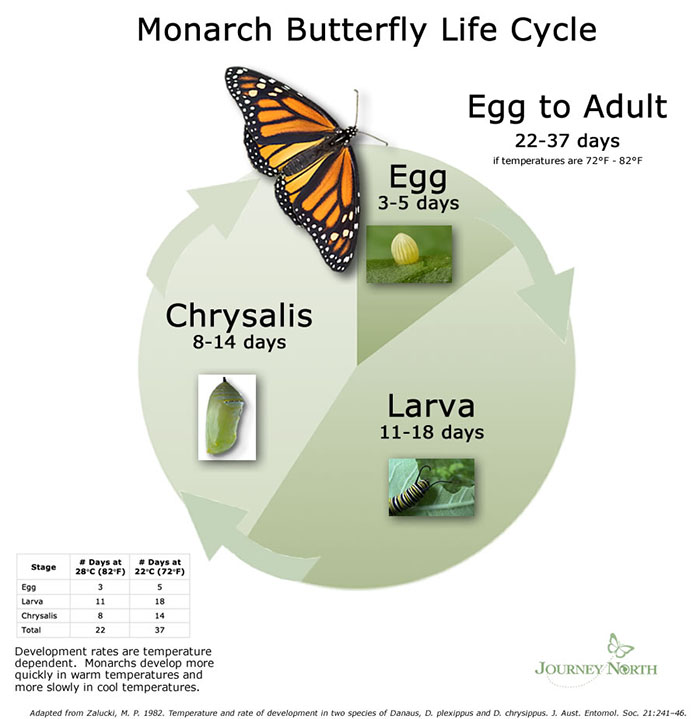Monarch butterflies
are recognised globally as an endangered species
In the America's, the winter hibernation locations of Mexico and California are rapidly shrinking due to deforestation,
harsh weather, development and other habitat disruptions. Because monarchs gather only in a few locations, the overall population is at
risk. The biggest threat is climate change.
Our breeding program
Each year Sacred Blessing Sanctuary Garden breeds 1000-2000 monarch butterflies to add to the local population of Waiheke Island. The
monarch butterflies can be seen in the garden predominately from November to
March
each year.
EGG
3 - 5 DAYS TO HATCH
The females monach butterflys lay about 300-400 eggs in their lifespan, which is about 40 per days. They lay their eggs on the underside of
a milkweed leaf. The eggs attach to the leaves with a special glue like substance. As the larva develops, the egg changes in colour.
The egg turns a grey colour when it is about to hatch, and the black head of the baby caterpillar is visible. Hatching occurs in
3-5 days. They eat their way out of their eggshell, and then eat the shell, which is full of protein, for their fast growing body.
LARVA STAGE (CATERPILLAR)
11 - 18 DAYS TO GROW
The baby caterpillar spends its day eating plants in order to grow larger. In 11-18 days, the caterpillar grows about 2,700 times
its birth weight. Its main food source is the milkweed species of plants.
The growing caterpillar moults five times through its growing stage. As it grows, it becomes too big for its skin (exoskeleton) so it
moults (sheds) its skin, and the moulting process repeats until the caterpillar reaches its full size.
PUPA STAGE (CHRYSALIS)
8 - 14 DAYS FOR METAMORPHOSIS
After the caterpillar is fully grown, it will find a sheltered place to attach itself in an upside down "J" shape. It will
then start the process of metamorphosis, that is, transforming from the caterpillar into the butterfly within the chrysalis, which can
take 8-14 days (depending on the outside temperature). Within the chrysalis, the caterpillar dissolves into a soup-like fluid, then
it miraculously reforms its DNA / cells into the structure of the butterfly.
IMAGO (ADULT) STAGE
BUTTERFLY EMERGES
The monarch butterfly will emerge hanging upside down from the pupa (chrysalis) with an enlarged abdomen that is full of fluid. By
hanging upside down (downwards), gravity will assist the butterfly to pump the fluid from the abdomen into their wings. This allows the
wings to expand and grow. The monach butterly then is still so that the wings can dry so it then may begin to fly.
Monarch butterflies typically live 2 to 6 weeks during the summer months. However, the last generation of the season will live for the
entire winter hibernation period. As temperatures cool (with winter approaching) the monarch butterfly migrates to its wintering location.
This monarch butterfly can live up to 9 months during the winter hibernation period. After it's winter hibernation, and when temperatures
warm, it emerges, and then migrates to it's summer location, and the incredible cycle starts all over again.
FEMALE & MALE
The female monarch butterly has thicker black webbing (veins) within their wings, and darker abdomens that are shaped differently.
The males also have two black scent glands (spots) at the centre of the hindwings to attract females. The two black spots make identifying
the males easy.
NECTAR PLANTS & SWAN PLANTS
Any garden plants rich in nectar will attract monarch butterflies. However, it is the milkweed family of plants (the Asclepias
genus), and most notably the plant commonly referred to as the Swanplant, that the monarch butterflies use as a host plant for the laying
of their eggs, and also as their food source when they are in their caterpillar form. It is commonly referred to as the Swan Plant, due to
the shape of the plant's seed pod, whcih when held in the correct orientation, resembles the shape of a swan.
WINTER / HIBERNATION MONTHS
Monarch butterflies in New Zealand do not follow the same migration pattern of their northern relatives. The butterflies have adapted
their migration behaviour to suit local conditions. When the air temperature drops to 12.8 degrees Celsius, - 55 F (around April or
May), the monarch butterflys flock together to their over-wintering sites. It is assumed there are wintering sites on Waiheke Island.
When the temperature warms up, the wintering butterflies emerge and start to reproduce.
PESTS
Pests of the monarch caterpillar include the brown soldier bug, praying mantis and wasps. To protect the caterpillar from these
pests, at Sacred Blessing Sanctuary Garden we use two netted nurseries to keep them safe from being eaten.
